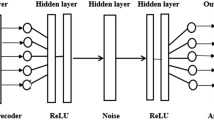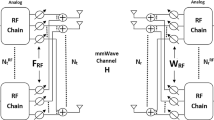Abstract
For 6G communications, the Ultra Massive Multiple Input Multiple Output (UM-MIMO) systems with Intelligent Reflecting Surface (IRS) assistance are capable since they can efficiently get beyond the limitations of restricted blockage and coverage. However, in the far field, a robust THz channel sparsity is unfavorable to spatial multiplexing, whereas excessive UM-MIMO and IRS dimensions extend the near field region. To address these issues, a hybrid beamforming IRS assisted UM-MIMO THz system with Deep Siamese Capsule Network is designed with the cascaded channel. The near and far field codebook-based beamforming is developed to model the proposed communication channel. The channel estimation is done based on the deep siamese capsule adaptive beluga whale neural network. The simulation results of the bit error rate, Normalized Mean Square Error (NMSE), spectral efficiency, sum rate, data rate, normalized channel gain, beamforming gain, and array gain loss shows that the proposed system achieves reliable performances compared with existing techniques. The suggested approach also demonstrates the outstanding adaptability to various network configurations and good scalability. The method provides a better channel estimation accuracy and less complexity which shows an NMSE of − 11.2 dB at an SNR of 10 dB.

















Similar content being viewed by others
Data availability
Data sharing not applicable to this article as no datasets were generated or analysed during the current study.
References
Yu, W., Shen, Y., He, H., Yu, X., Song, S., Zhang, J., & Letaief, K. B. (2023). An adaptive and robust deep learning framework for thz ultra-massive MIMO channel estimation. IEEE Journal of Selected Topics in Signal Processing. https://doi.org/10.1109/jstsp.2023.3282832
Tarboush, S., Ali, A., & Al-Naffouri, T. Y. (2023). Compressive estimation of near field channels for Ultra Massive-MIMO wideband the systems. ICASSP 2023 - 2023 IEEE International Conference on Acoustics, Speech and Signal Processing (ICASSP). https://doi.org/10.1109/icassp49357.2023.10096832
Elbir, A. M., Shi, W., Papazafeiropoulos, A. K., Kourtessis, P., & Chatzinotas, S. (2023). Near-field terahertz communications: Model-based and model-free channel estimation. IEEE Access, 11, 36409–36420. https://doi.org/10.1109/access.2023.3266297
Chen, K., Qi, C., & Wang, C.-X. (2022). Two-stage hybrid-field beam training for ultra-massive MIMO Systems. 2022 IEEE/CIC International Conference on Communications in China (ICCC). https://doi.org/10.1109/iccc55456.2022.9880793
Cai, X., Cheng, X., & Tufvesson, F. (2024). Toward 6G with terahertz communications: Understanding the propagation channels. IEEE Communications Magazine, 62(2), 32–38.
Chen, Y., Yan, L., & Han, C. (2021). Hybrid spherical- and planar-wave modeling and DCNN-powered estimation of terahertz ultra-massive MIMO channels. IEEE Transactions on Communications, 69(10), 7063–7076. https://doi.org/10.1109/tcomm.2021.3098696
Elbir, A. M., Mishra, K. V., & Chatzinotas, S. (2021). Terahertz-band joint ultra-massive MIMO radar-communications: Model-based and model-free hybrid beamforming. IEEE Journal of Selected Topics in Signal Processing, 15(6), 1468–1483. https://doi.org/10.1109/jstsp.2021.3117410
Ning, B., Tian, Z., Mei, W., Chen, Z., Han, C., Li, S., & Zhang, R. (2023). Beamforming technologies for ultra-massive MIMO in terahertz communications. IEEE Open Journal of the Communications Society, 4, 614–658. https://doi.org/10.1109/ojcoms.2023.3245669
Hu, Z., Chen, Y., & Han, C. (2023). Prince: A pruned AMP Integrated Deep CNN Method for efficient channel estimation of millimeter-wave and terahertz ultra-massive MIMO Systems. IEEE Transactions on Wireless Communications. https://doi.org/10.1109/twc.2023.3258405
**ao, L., Li, S., Liu, Y., Liu, G., **ao, P., & Jiang, T. (2023). Error probability analysis for ultra-massive MIMO system and near-optimal signal detection. China Communications. https://doi.org/10.23919/jcc.fa.2022-0630.202305
Kim, S., Lee, A., Ju, H., Ngo, K. A., Moon, J., & Shim, B. (2023). Transformer-based channel parameter acquisition for terahertz ultra-massive MIMO Systems. IEEE Transactions on Vehicular Technology. https://doi.org/10.1109/tvt.2023.3287530
Yan, L., Han, C., Yang, T., & Yuan, J. (2021). Dynamic-subarray with fixed-true-time-delay architecture for terahertz wideband hybrid beamforming. 2021 IEEE Global Communications Conference (GLOBECOM). https://doi.org/10.1109/globecom46510.2021.9685038
Yan, L., Han, C., & Yuan, J. (2022). Energy-efficient dynamic-subarray with fixed true-time-delay design for terahertz wideband hybrid beamforming. IEEE Journal on Selected Areas in Communications, 40(10), 2840–2854. https://doi.org/10.1109/jsac.2022.3196090
Ranjith, S., Jesu Jayarin, P., & Chandra Sekar, A. (2023). A multi-fusion integrated end-to-end deep kernel CNN based channel estimation for hybrid range UM-MIMO 6G Communication Systems. Applied Acoustics, 210, 109427. https://doi.org/10.1016/j.apacoust.2023.109427
Chen, Y., & Han, C. (2020a). Deep CNN-based spherical-wave channel estimation for terahertz ultra-massive MIMO Systems. GLOBECOM 2020-2020 IEEE Global Communications Conference. https://doi.org/10.1109/globecom42002.2020.9322174
Tarboush, S., Ali, A., & Al-Naffouri, T. Y. (2024). Cross-field channel estimation for ultra massive-MIMO THz systems. IEEE Transactions on Wireless Communications. https://doi.org/10.1109/TWC.2024.3352894
Liao, A., Gao, Z., Wang, D., Wang, H., Yin, H., Ng, D. W. K., & Alouini, M. S. (2021). Terahertz ultra-massive MIMO-based aeronautical communications in space-air-ground integrated networks. IEEE Journal on Selected Areas in Communications, 39(6), 1741–1767.
Lee, A., Ju, H., Kim, S., & Shim, B. (2022). Intelligent near-field channel estimation for terahertz ultra-massive MIMO Systems. GLOBECOM 2022-2022 IEEE Global Communications Conference. https://doi.org/10.1109/globecom48099.2022.10001612
Murshed, R. U., Ashraf, Z. B., Hridhon, A. H., Munasinghe, K., Jamalipour, A., & Hossain, Md. F. (2023). A CNN-LSTM-based fusion separation deep neural network for 6G ultra-massive MIMO hybrid beamforming. IEEE Access, 11, 38614–38630. https://doi.org/10.1109/access.2023.3266355
Chen, Z., Han, C., Wu, Y., Li, L., Huang, C., Zhang, Z., & Tong, W. (2021). Terahertz wireless communications for 2030 and beyond: A cutting-edge frontier. IEEE Communications Magazine, 59(11), 66–72.
Singh, P., & Jung, S. Y. (2022). Nanonetworks: Next Frontier in Wireless Communications. In 2022 13th International Conference on Information and Communication Technology Convergence (ICTC) (pp. 685–690). IEEE.
Li, R., Sun, S., Chen, Y., Han, C., & Tao, M. (2022). Ergodic achievable rate analysis and optimization of RIS-assisted millimeter-wave MIMO communication systems. IEEE Transactions on Wireless Communications, 22(2), 972–985.
Moon, S., Kim, H., & Hwang, I. (2020). Deep learning-based channel estimation and tracking for millimeter-wave vehicular communications. Journal of Communications and Networks, 22(3), 177–184. https://doi.org/10.1109/jcn.2020.000012
Elbir, A. M., Shi, W., Papazafeiropoulos, A. K., Kourtessis, P., & Chatzinotas, S. (2023). Terahertz-band channel and beam split estimation via array perturbation model. IEEE Open Journal of the Communications Society, 4, 892–907. https://doi.org/10.1109/ojcoms.2023.3263625
Yan, L., Chen, Y., Han, C., & Yuan, J. (2022). Joint Inter-Path and intra-path multiplexing for terahertz widely-spaced multi-subarray hybrid beamforming systems. IEEE Transactions on Communications, 70(2), 1391–1406. https://doi.org/10.1109/tcomm.2021.3138791
Chen, Y., Li, R., Han, C., Sun, S., & Tao, M. (2023). Hybrid spherical- and Planar-wave channel modeling and estimation for terahertz integrated UM-MIMO and IRS systems. IEEE Transactions on Wireless Communications. https://doi.org/10.1109/twc.2023.3273221
Han, C., Yan, L., & Yuan, J. (2021). Hybrid beamforming for terahertz wireless communications: Challenges, architectures, and open problems. IEEE Wireless Communications, 28(4), 198–204. https://doi.org/10.1109/mwc.001.2000458
Madhu, G., Govardhan, A., Ravi, V., Kautish, S., Srinivas, B. S., Chaudhary, T., & Kumar, M. (2022). DSCN-net: A Deep Siamese capsule neural network model for automatic diagnosis of malaria parasites detection. Multimedia Tools and Applications, 81(23), 34105–34127. https://doi.org/10.1007/s11042-022-13008-6
Wu, Y., Li, J., Wu, J., & Chang, J. (2020). Siamese capsule networks with global and local features for text classification. Neurocomputing, 390, 88–98. https://doi.org/10.1016/j.neucom.2020.01.064
Zhong, C., Li, G., & Meng, Z. (2022). Beluga whale optimization: A novel nature-inspired metaheuristic algorithm. Knowledge-Based Systems, 251, 109215. https://doi.org/10.1016/j.knosys.2022.109215
Acknowledgements
None.
Funding
This research did not receive any specific grant from funding agencies in the public, commercial, or not-for-profit sectors.
Author information
Authors and Affiliations
Contributions
All the authors have contributed equally to the work.
Corresponding author
Ethics declarations
Conflict of interest
The authors declare that they have no potential conflict of interest.
Ethical approval
All applicable institutional and/or national guidelines for the care and use of animals were followed.
Informed consent
For this type of analysis formal consent is not needed.
Additional information
Publisher's Note
Springer Nature remains neutral with regard to jurisdictional claims in published maps and institutional affiliations.
Rights and permissions
Springer Nature or its licensor (e.g. a society or other partner) holds exclusive rights to this article under a publishing agreement with the author(s) or other rightsholder(s); author self-archiving of the accepted manuscript version of this article is solely governed by the terms of such publishing agreement and applicable law.
About this article
Cite this article
Govindasamy, R., Nagarajan, S.K., Muthu, J.R. et al. Deep optimized hybrid beamforming intelligent reflecting surface assisted UM-MIMO THz communication for 6G broad band connectivity. Telecommun Syst (2024). https://doi.org/10.1007/s11235-024-01157-y
Accepted:
Published:
DOI: https://doi.org/10.1007/s11235-024-01157-y




